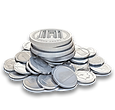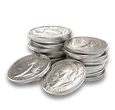Why the Same Coin Can Sell for Different Prices at Auction
- GoldsilverJapan

- Sep 30
- 6 min read
Understanding the Complex World of Rare Coin Valuations
In the world of numismatics, one of the most perplexing phenomena for both new and seasoned collectors is this: Why does the same coin sometimes sell for drastically different prices at auction?
You might see a 1907 High Relief Saint-Gaudens Double Eagle fetch $30,000 in one auction, and then see another of the same type and grade sell for $45,000 just months later. What gives?
The answer lies in a complex blend of market dynamics, collector psychology, timing, and auction-specific factors. This article explores the key reasons why identical or near-identical coins can achieve widely different results at auction—and how you can better navigate these inconsistencies as a collector or investor.
🔍 1. Understanding What “Same Coin” Really Means
Before diving in, we must clarify an important point: when we say “same coin,” it often refers to same type, year, mint mark, and certified grade. But in practice, coins—even those with identical designations—are rarely “truly” identical.
Two MS-65 1925-D Saint-Gaudens Double Eagles may differ significantly in terms of eye appeal, luster, strike, and toning—factors that can strongly influence final prices. Even minor details, imperceptible to the untrained eye, can cause large valuation swings.
💰 2. Eye Appeal and Subjective Quality
Eye appeal is one of the most powerful drivers of price. It refers to the coin’s visual attractiveness—how it looks in hand or under magnification.
Some MS-65 coins may look closer to MS-66 quality due to their vibrant luster or near-perfect strike, while others may barely qualify.
Key Eye Appeal Factors:
Luster (brightness)
Strike quality
Color or toning (e.g., natural rainbow toning)
Surface cleanliness
Centering and detail sharpness
Even when graded equally, a coin with superior eye appeal can fetch 10% to 100% more at auction.
🧠 3. Collector Psychology and Emotional Bidding
Collectors are human. And humans are emotional. Coin auctions are not just financial transactions—they’re emotional battles. Bidders are often driven by:
FOMO (Fear of Missing Out)
Ego and the desire to “win” an item
Passion for a specific coin or type
Completion syndrome (finishing a registry set)
This emotional factor can lead to bidding wars that drive a coin's price well above its estimated market value—especially if two or more determined bidders are involved.
⏰ 4. Timing and Market Sentiment
The timing of a sale matters—a lot.
When gold prices are surging or when a particular historical period is “hot” (e.g., Civil War memorabilia), coin prices tend to rise. The same coin might perform very differently depending on:
The macro environment (inflation, interest rates, global tensions)
Bull vs bear cycles in precious metals
Numismatic market trends (e.g., early American copper coins may trend at one time, Morgan dollars at another)
Example:
During the 2020 COVID-19 crisis, demand for physical assets spiked. Coins—especially gold and silver bullion types—saw dramatic increases in both dealer and auction prices.
📦 5. Auction House Reputation and Reach
Not all auctions are created equal. The platform on which a coin is sold plays a critical role in determining its final price.
High-Profile Auction Houses:
Heritage Auctions
Stack’s Bowers
Sotheby’s
Christie’s
These houses have global reach, prestige, and elite clientele. Coins sold through them often fetch significantly higher prices than at lesser-known or local auctions.
Smaller or Local Auctions:
Lower buyer confidence
Reduced exposure
Less aggressive bidding
Even a rare coin can underperform if it’s not marketed effectively or shown to the right audience.
🧾 6. Lot Order and Auction Format
Believe it or not, where your coin appears in an auction catalog can impact its hammer price.
Early lots tend to get more attention.
If a “key date” coin follows a similar coin, it may cannibalize the interest or budget of bidders.
Live bidding vs. timed online sales affects excitement and urgency.
Multi-day auctions may lead to “bid fatigue.”
Also, bundled lots or “box lots” of multiple coins can perform differently than single-item spotlight sales.
🧑⚖️ 7. Grading Service and Holder Type
Even coins of the same grade can be valued differently depending on the grading service (PCGS vs. NGC vs. ANACS) and even the generation of the holder.
Collectors often place higher trust in:
PCGS “First Strike” or “Gold Shield” coins
NGC “Early Release” or “Star Designation”
“Old green holders” or “rattlers” seen as undergraded by modern standards
These small differences can produce big price disparities, especially for high-end collectors.
📈 8. Registry Set Competition
Registry sets are competitive displays of graded coins on services like PCGS Set Registry or NGC Collectors Society. Top collectors compete to own the finest possible examples.
When a rare coin appears that could boost a registry set’s score, expect fireworks. A single MS-67 coin—needed to complete a “Top 5” Morgan dollar set—can sell for double or triple its normal market value because a top-set owner must have it.
This artificially drives price for reasons that have nothing to do with traditional valuation.
🔍 9. Provenance and Pedigree
A coin’s backstory can add significant value. Coins that once belonged to:
Famous collectors (e.g., King Farouk, Eliasberg, Norweb)
Historic auctions (Garrett Collection, Pittman Collection)
Celebrity owners (actors, politicians)
…tend to carry a pedigree premium. Even identical coins without a known history may fetch less.
🧮 10. Bidding Environment: Floor vs. Online
Live floor bidding, where participants feed off each other’s energy, often results in higher prices than:
Online-only auctions
Phone bidding
Absentee bidding
In-person auctions stir competitiveness, excitement, and impulse. Online auctions may be more “rational,” but often lack urgency.
🎯 11. Reserve Prices and Opening Bids
Coins with high reserve prices might fail to sell, while those starting at $1 may ignite a bidding war.
Interestingly, low-start auctions often outperform because bidders feel emotionally invested after placing an early low bid. This increases the chance of continued participation as price rises.
🧊 12. Market Saturation and Recent Sales
If a specific coin type has flooded the market recently, or if a similar piece sold at auction last month, it can depress the current price.
Collectors tend to hold back if they’ve seen too many examples too recently. On the flip side, lack of supply can inflate prices quickly.
💡 13. Photography and Marketing
Don’t underestimate the power of a good photo. High-resolution, professionally lit coin photos increase bidder confidence and perceived value.
If a coin is photographed poorly (bad lighting, blurry image), it may:
Appear to have flaws it doesn’t have
Look flat or unappealing
Discourage competitive bidding
The catalog description, title, and pre-auction buzz also contribute to final hammer price.
📚 14. Notable Examples of Price Disparities
Let’s look at some real-world cases:
Case A: 1933 Saint-Gaudens Double Eagle
Sold for $7.5 million in 2002
Sold again for $18.9 million in 2021
Same coin—why the difference? Time, marketing, legal status, and bidder profile.
Case B: 1909-S VDB Lincoln Cent (MS-66 RD)
Heritage Auctions (2020): $50,000
GreatCollections (2021): $74,000
Higher price driven by collector set-building.
📉 15. What Does This Mean for Sellers?
If you're planning to sell a coin at auction, consider these tips:
Choose the right auction house (with reach and reputation).
Time your sale with favorable market conditions.
Ensure your coin is professionally photographed and well described.
Don’t sell in a crowded category—wait for the right moment.
Consider third-party appraisal or marketing help.
Even small details can add thousands of dollars to your final price.
💼 16. Advice for Buyers: Don’t Overpay on Hype
Buyers should stay grounded. Avoid letting emotion or FOMO lead to irrational overbidding.
Questions to ask:
Is this coin truly rare, or just hot right now?
Are you paying for eye appeal, history, or hype?
Has the same coin sold recently for less?
Use past sales as benchmarks, and consider waiting for a more favorable buying window.
🧠 17. Long-Term Impacts on Market Value
Price disparities have long-term ripple effects:
Establish new benchmarks for similar coins
Raise expectations (and premiums) for specific series
Shape collector sentiment and registry scores
A record-setting sale can change how a coin is viewed for years to come.
🧭 18. Conclusion: The True Nature of Coin Auctions
Auction results don’t always reflect “fair market value.” Instead, they’re a snapshot of:
Emotions
Timing
Audience
Presentation
Coin auctions are not pure price discovery mechanisms—they’re part theater, part psychology, part economics. That’s what makes them thrilling—but also risky.
Whether you’re buying or selling, understanding these dynamics helps you make smarter decisions—and avoid paying (or accepting) the wrong price.











Comments